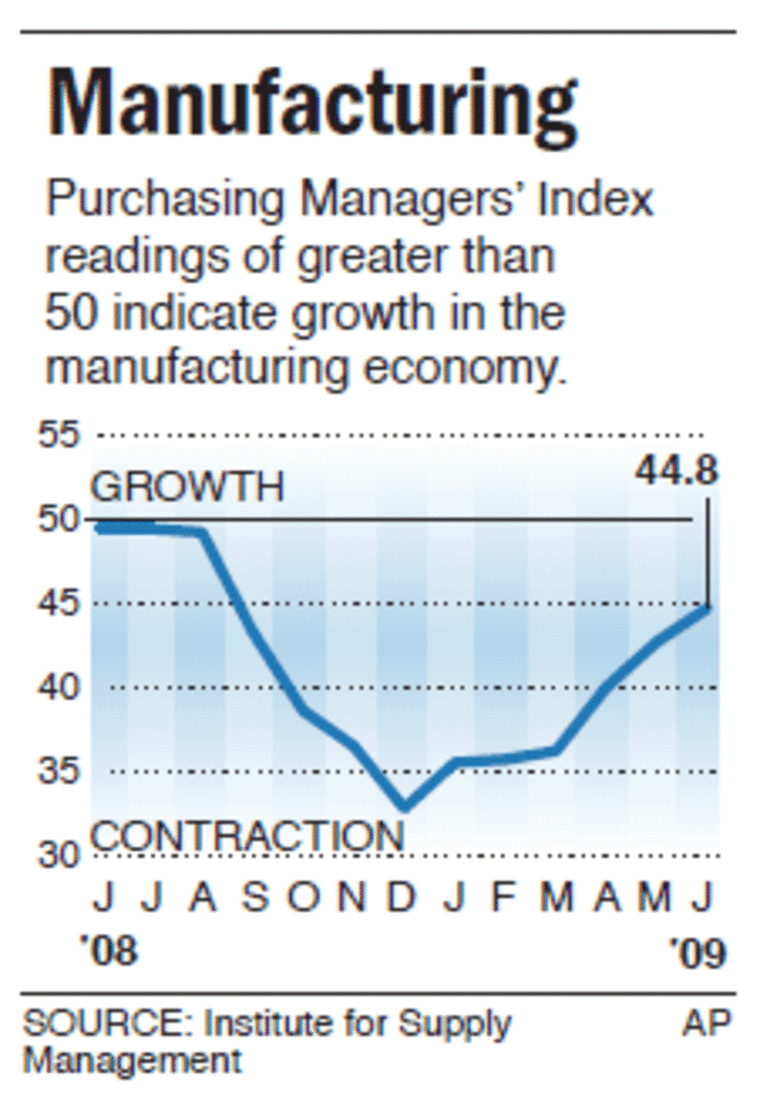Brighter news on manufacturing is offering more hope that the longest recession since World War II is near an end. But with construction and many other segments of the economy still weak and unemployment rising, any rebound likely will be slow.
A key gauge of manufacturing showed Wednesday that industry activity declined less than expected in June. The Institute of Supply Management's manufacturing index posted a 44.8 — the best showing since last August, a month before the financial crisis erupted with force.
Manufacturing sectors overseas also signaled a bit of a rebound, though other U.S. economic news was more mixed. Ford Motor Co. reported the smallest sales decline of the year in June, but sales at struggling Chrysler Group LLC continued to plunge.
Outside of manufacturing, construction spending fell in May for the seventh time in the past eight months. Spending dropped more than expected as strength in nonresidential building was eclipsed by a decline in housing construction and weakness in government projects.
But in a hint of better days to come, the National Association of Realtors said an index of pending home sales edged up 0.1 percent in May. It was the fourth straight advance for the index, which tracks contracts to buy previously owned homes.
"I think the great recession is winding down," said Mark Zandi, chief economist at Moody's Economy.com. "Retailing should firm a bit in the next few months, helped by the stimulus package, and I think lean inventories will trigger production increases."
After a period last winter when the economic news was unrelentingly bad, many analysts said the mixed nature of the new reports showed an economy starting to turn the corner. But they cautioned against expecting anything but a weak recovery.
"This downturn was too big and too global an event to hope that the bottoming process will be quick," said Cliff Waldman, an economist with the Manufacturers Alliances/MAPI, an industry trade group. "I think the economy is going to take two steps forward and one step back."

The recession began in December 2007 and intensified last fall after the most severe financial crisis since the 1930s. The overall economy, as measured by the gross domestic product, shrank at an annual rate of 6.3 percent in the October-December quarter and by 5.5 percent in the first three months of this year. That was the steepest six-month decline in a half-century.
Many economists say they think the drop in GDP slowed to about 2 percent in the April-June quarter. More optimistic analysts believe the economy will start growing again in the current July-September period, helped by the government's stimulus spending.
Zandi said the $787 billion stimulus package of increased government spending and tax cuts should translate into a sizable boost to the economy in this quarter, turning what would have been another GDP decline into a small increase of around 1 percent.
But the rebound in GDP won't halt a continued rise in unemployment, which is a lagging economic indicator. Economists predict the unemployment rate climbed to 9.6 percent last month, from a 25-year high of 9.4 percent in May. The June report will be released Thursday.
Zandi expects unemployment to top out at 10.5 percent next spring, close to the 10.8 percent hit in late 1982, the highest jobless rate since World War II.
The 44.8 reading for the ISM manufacturing index in June was up from 42.8 in May and marked the highest point for the index since August. Any reading below 50 is viewed as a signal of contraction in manufacturing.
But economists were heartened by the upward trend in recent months: This is the second straight month that the index has been above 41.2. ISM analysts said this was consistent with an expansion for the overall economy even though manufacturing is still shrinking.
"A slow recovery for manufacturing is forming," said Norbert Ore, chair of the ISM's manufacturing business survey committee.
Other reports were encouraging for manufacturing in other countries. Two reports from China, the world's third-largest economy, showed small gains in surveys of manufacturers. Elsewhere, the purchasing managers index from the 16-nation euro zone showed a slower pace of decline in June. And the equivalent index in Britain hit a 15-month high of 47.
British manufacturing output rose for the first time since March 2008. Big Japanese manufacturers reported being slightly more optimistic about business conditions but cut capital spending sharply.
The ISM survey of U.S. activity hasn't noted growth in manufacturing since January 2008. The index includes new orders, production, employment, inventories, prices, and export and import orders. It is based on a survey of ISM members from 18 industries.
The third quarter started on a positive note on Wall Street as investors hoped an economic recovery was beginning to take shape. The Dow Jones industrial average added more than 57 points 8,504.06, and broader indexes also gained.
The pace of manufacturing layoffs may have slowed since winter but it has not stopped.
Farm machinery company Deere & Co. said this week that 800 salaried employees, or 3 percent of its salaried work force, took a voluntary buyout offer. That's four times as many as the company expected when it announced the program in April.
In June, Cessna Aircraft Co., which makes corporate jets, said it would cut 1,300 jobs by this summer on top of 6,900 earlier layoffs.